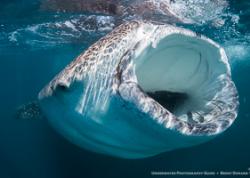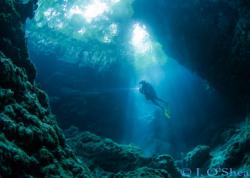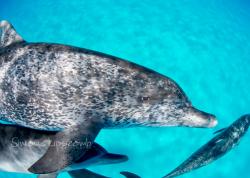Return to Tiger Beach
Return To Tiger Beach
A photo essay from the northern Bahamas featuring sharks, sharks and more sharks!
By Steve Rosenberg
In January 2012, I made a return trip to Tiger Beach with Jim Abernethy’s Scuba Adventures for another one of their incredible week-long shark adventures to the northern Bahamas. It had just been too long since my last shark adventure on the MV Shearwater. As a bonus, Andy Sallmon, who is an outstanding professional underwater photographer from Southern California, was on the boat. Between Jim and Andy you can’t help get but pick up some useful tips on shooting sharks. During the trip, Captain Mike mounted a Go Pro Camera on a remote controlled boat speed boat and enticed a couple of tiger sharks to try their hand at boating. Fortunately, Mike recovered the GoPro and Andy got some incredible images of the event.
.jpg)
Just another tiger shark at the surface. The crew persuaded some of the passengers to dangle their toes in the water off the dive platform. It worked great to get the tigers to open their mouths for a few awesome close-ups.
The Adventure
The week started off a bit rough and windy. Jim elected to visit two shallow reefs before heading out to Tiger Beach. After one day of bad weather, the winds eased and the seas calmed down, making the entries and exits a piece of cake and the surface intervals between dives very comfortable. We spent a day with amazing shark interactions at Hammertime reef and Ginormous reef. There were plenty of opportunities to set up unusual photographs at the end of swim-throughs and atop indentations in the coral reef with sharks continually making fly-bys and swim-overs. We took advantage of the opportunity to allow some of the Caribbean reef sharks to pose with splashes of colorful sponges and lionfish. Despite a persistent wind and somewhat spotty visibility we had awesome close-up encounters with Caribbean reef sharks, lemon sharks, a tiger shark and a friendly Goliath Grouper.
.jpg)
Duck!... and if it occurs to you, press the shutter. This was actually one of those opportunities where you have to anticipate...
Later when we parked at Tiger Beach and after the wind had died down a bit, we were treated to more incredible photographic opportunities. The various sections of Tiger beach are only about 20 feet deep, but feature swarming lemon sharks, intermixed with visits from tigers measuring up to 18 feet in length. It's always an exhilarating experience to grab your camera at the swim step, duck your mask into the water and roll forward with 20 or 30 lemon sharks milling about the dive platform. The lemon sharks, measuring up to 10 feet in length, sport a toothy sinister smile and their sleek ‘fighter jet’ profiles make for awe-inspiring portraits. However, the tigers are the real "super models," measuring up to an incredible 18 feet in length. The tiger sharks deserve, and require, your constant attention. On this trip we were underwater with as many as eight tigers at a time.
As an underwater photographer I have had the good fortune to work on assignments shooting sharks all over the globe. Jim Abernethy runs a very professional “stick to the rules” operation that allows photographers and videographers one-of-a-kind encounters with a variety of large predators that are available nowhere else in the world. Passengers on his live-aboard boat, the Shearwater, are treated to Jim’s hands-on expertise in dealing with sharks and his awesome knowledge of photographing large predators. I can’t wait to go again for another unique shark adventure, always looking for those one of a kind images.
.jpg)
For a lot of reasons, especially when you are diving with sharks, it is a good idea to be constantly looking around in all directions. When you have good visibility, look for situations where you can put subjects in the background, whether its the boat, sharks or other other divers. It's is a good way to add the the dimension of depth to your pictures.
Underwater Photo Tips
The photo opportunities on one of Jim’s shark trips are so plentiful that you don’t have to rush and just take snap shots. The best advice that I can give you is to listen to Jim Abernethy. He is the kind of person who is genuinely excited about helping his passengers get extraordinary shots. That said, when you get underwater, take your time and try to visualize what a shot will look like. Anticipate the angle of your subject and what is going on in the negative space around your subject. Try to isolate the subject(s) and get them swimming toward the lens at an angle.
Get as close as possible to your subjects and work on getting upward angle. You will discover that the first part isn’t that difficult. Of course, you won’t have the luxury of burying your face in the viewfinder. You really need to keep track of where the sharks are at all times, especially the tigers. Learn to anticipate when a picture is about to happen, pre-positioning your camera in front of you. Look into the viewfinder at the last moment, take the shot and then get back to looking around you to keep track of the rest of your subjects. When you dive with tigers its pretty much a matter of teamwork and everyone has to do their part.
.jpg)
Sheer boredom. I'm pretty sure sure that this Caribbean Reef shark was only yawning from sheer boredom. The troublesome thing was that I could see he was pretty empty and probably somewhat hungry.
.jpg)
This picture of a close-up of a lemon shark was taken with the idea of adding another layer to the image by using a camera angle that would include a second shark higher in the water column.
.jpg)
Lionfish with Caribbean Reef Shark. Unfortunately, there were many volitans lionfish on the reefs. I persuaded this one to pose patiently just off the reef, while we waited for a Caribbean Reef shark to swim into the frame. The key to this type of picture is patience!
.jpg)
When we were swimming around the shallow reefs sometimes these types of images kind of just happened. You just have to be ready with the right exposure already dialed in and take the image. You have to learn to anticipate what the image will look like through the viewfinder, being sure to look around the subject for unwanted body parts in the picture. Of course, I am talking about shark tails, stray fishes, etc (not pieces of divers) that would detract from the image.
.jpg)
Rush hour. Jim dumped us on one of the shallow reefs during the commute hour, enabling us to sit in traffic and get all makes and models of Caribbean Reef Sharks.
.jpg)
Getting toothy displays and wide open mouths is pretty much luck. However, if you take an occasional test shot to check exposure, etc. you will be much more likely to be able to successfully shoot from the hip when a cool behavioral shot unfolds.

Tiger portrait. This is the type of shot where you want to try to anticipate the angle of the subject and use a camera angle that will give you an empty negative space around your subject. By getting close and using upward angles, you can isolate your subject to obtain pretty dramatic shots against open water backgrounds
.jpg)
Sharks on the reef. One of the techniques we used on the shallow reefs was to set up a picture with sponges in the foreground and then wait (and wait) for the sharks to swim into the picture.
.jpg)
This was just a case of aiming the camera to get a couple of lemon sharks oriented properly in the frame and be conscious of excluding the other 38 lemon sharks (and their various body parts) from the picture.
.jpg)
This Goliath grouper with it's mouth open was one of those instances where you have to be ready for a shot and just take advantage when it unfolds in front of you. Just be careful not to get sucked in when it opens its mouth. I wonder if Jonah was an underwater photographer.
.jpg)
Pair of reef sharks. Look for situations where you can get subjects interacting in the frame. This opportunity of getting a pair of Caribbean reef sharks lined up in a parallel configuration seemed like a good idea (even while I was taking the picture).
About the Author
Steve has been a professional underwater photographer and photojournalist since 1980. He has produced eight travel guides for dive destinations, including The Hawaiian Islands, Cozumel, The Turks & Caicos, The Galapagos Islands, The Bahamas and Northern California, and has written hundreds articles for various U.S. publications on dive destinations, underwater photography, and marine biology. He has also produced numerous coffee table books on various destinations. Thousands of his images have appeared in books, magazines, and posters, as well as on stamps, advertising, and art work worldwide. He has also won more than 250 awards for his photography in international competitions, including a First Place Award in the prestigious Han Hass Competition in Austria. He received the Scuba Schools International Platinum Pro Certification for 5000 dives in 1996 and has been diving since the late 1960’s. He is an active member of the Society of American Travel Writers (SATW). Steve is a senior board member and contributing editor for ReefID.org. He can be contacted at sgr@pacbell.net.
Further reading
Support the Underwater Photography Guide
Please support the Underwater Photography Guide by purchasing your underwater photography gear through our sister site, Bluewater Photo and Video. Click, or call them at (310) 633-5052 for expert advice!
RECOMMENDED ARTICLES
SUPPORT THE UNDERWATER PHOTOGRAPHY GUIDE:
The Best Service & Prices on u/w Photo Gear
 Visit Bluewater Photo & Video for all your underwater photography and video gear. Click, or call the team at (310) 633-5052 for expert advice!
Visit Bluewater Photo & Video for all your underwater photography and video gear. Click, or call the team at (310) 633-5052 for expert advice!
The Best Pricing, Service & Expert Advice to Book your Dive Trips
 Bluewater Travel is your full-service scuba travel agency. Let our expert advisers plan and book your next dive vacation. Run by divers, for divers.
Bluewater Travel is your full-service scuba travel agency. Let our expert advisers plan and book your next dive vacation. Run by divers, for divers.






























